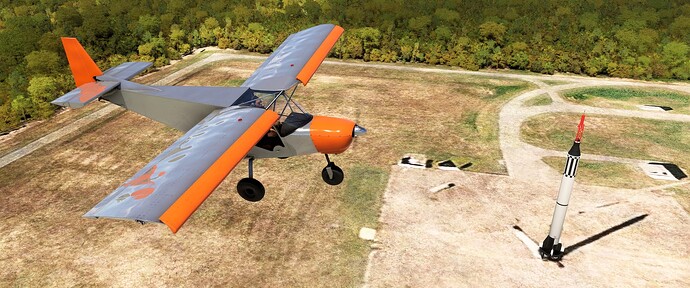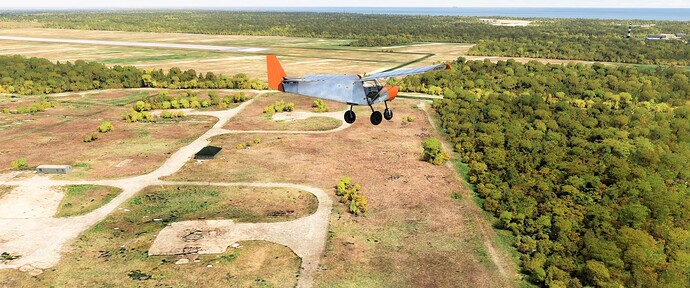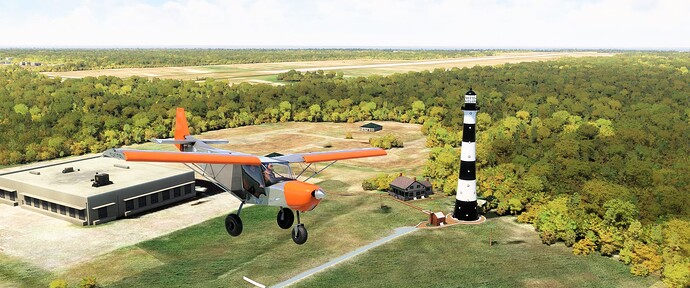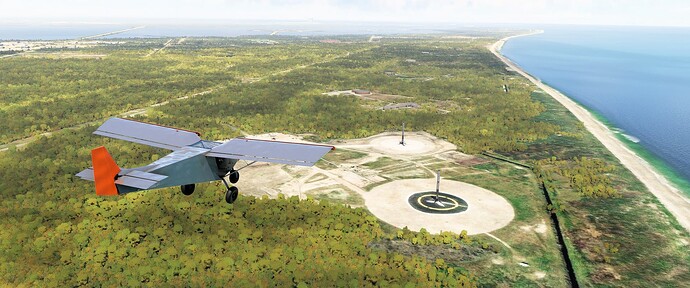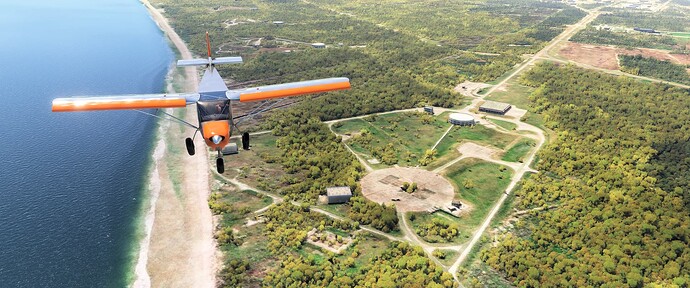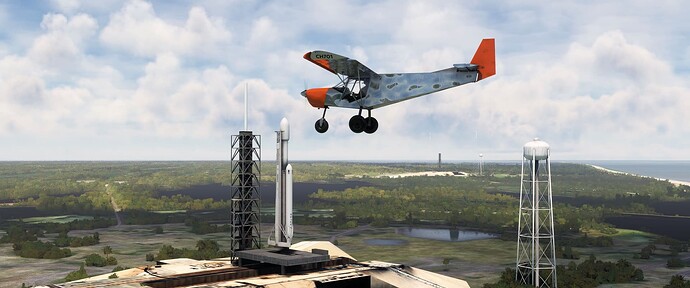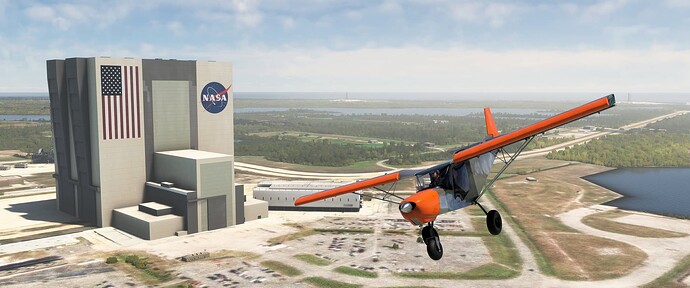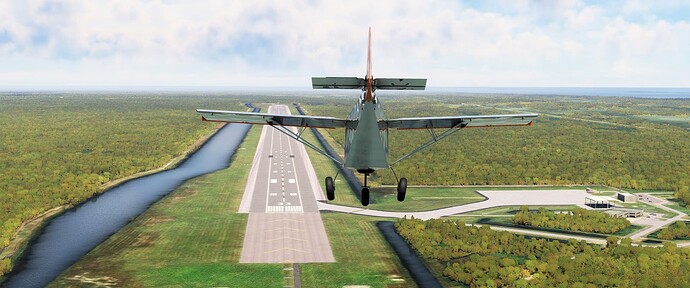Welcome back to Central Florida! At the end of Part 1, our intrepid heroes were turning north toward Cape Canaveral. Let’s pick up the story there…
But first, a little clarification:
-
Cape Canaveral is a headland on Florida’s Atlantic coast, separated from Merritt Island by the Banana River. It was renamed Cape Kennedy in 1963 but that name never stuck, and it officially reverted to Cape Canaveral in 1973.
-
The Cape Canaveral Space Force Station (formerly Air Force Station) is located on Cape Canaveral.
-
The Kennedy Space Center is located on Merritt Island, immediately northwest of the Space Force Station.
Non-locals almost always conflate these locales. The Space Shuttle didn’t launch from Cape Canaveral and the Mercury flights weren’t launched from the Kennedy Space Center. There’s no place named Cape Kennedy.
Pee-Wee says: Now when you visit Florida you can avoid sounding like a tourist. This concludes our public service announcement. ![]()
![]() Candle in the Wind: Launch Complex 5
Candle in the Wind: Launch Complex 5
MSFS: 28.439398 -80.573315
Skyvector: 282622N08034524W
Now here’s some real history! We’re over the Cape Canaveral Space Force Station, and below is Launch Complex 5 (LC-5), where Navy Lieutenant Commander Alan Shepard blasted off into American history aboard Freedom 7. Only two other Americans would fly here, both aboard Mercury-Redstone rockets: Air Force Captain Gus Grissom aboard Liberty Bell 7, and Ham the chimpanzee aboard Mercury-Redstone 2.
Freedom 7 is on display at the Smithsonian Air & Space Museum in Washington D.C. A mockup Mercury-Redstone rocket currently stands at LC-5 and may only be viewed by appointment when visiting the adjacent Cape Canaveral Space Force Museum. (You’d better hurry: this Redstone has already been blown over once by Hurricane Floyd.)
Pee-Wee says: We all know Shepard’s and Grissom’s stories, but what about chimpanzees Ham and his virtually unknown cohort Enos? Ham survived his harrowing flight aboard Mercury-Redstone 2 during which he experienced almost 15 g and overshot the intended landing site by 130 miles (210 kilometers). He died of natural causes in 1983 and is interred at the International Space Hall of Fame at Alamagordo.
Enos completed two orbits aboard Mercury-Atlas 5 and performed brilliantly in the face of compounding mechanical failures, including a malfunctioning environmental control system and an “avoidance conditioning” system that randomly zapped him with electrical shocks. Forced to deorbit earlier than planned, he endured three hours inside his floating spacecraft until the Navy arrived. Enos died from an intestinal infection in 1962. His remains were sent to the Smithsonian, but disappeared without a trace.
God speed and thank you, Little Chimps. ![]()
![]() From Test Site to Hallowed Ground: Launch Complex 31B
From Test Site to Hallowed Ground: Launch Complex 31B
MSFS: 28.451479 -80.555202
Skyvector: 282705N0803318W
About one and a third miles north of LC-5 is LC-31. Built in 1961 for testing the Air Force’s new Minuteman intercontinental ballistic missile, LC-31 and neighboring LC-32 both feature an above ground launch pad (LC-31A and -32A) and underground silo (LC-31B and -32B). Ninety-two Minutemen were launched from these two sites, including 35 from LC-31B and 53 from LC-32B. There are no recoded launches from LC-32A.
In this screenshot you can see LC-31B in front with LC-32B behind, immediately under our Zenith’s tail. That’s LC-31A in the lower left corner and 32A hiding in the trees across the road behind us. In the distance is a portion of the Skid Strip (KXMR), named for its initial use as the recovery strip for Snark missiles, which relied on metal skids rather than traditional landing gear. In the upper right corner is the Cape Canaveral Lighthouse.
The wreckage of OV-099 Challenger is interred inside LC-31B, although a single piece of her fuselage was exhumed in 2015 for display at a memorial inside the KSC Visitor Complex. Thirty-six years after her accident, a History Channel dive team searching for the PBM lost while searching for Flight 19 stumbled upon a large section of Challenger partly buried in the seabed off Cape Canaveral. Per the surviving familes’ wishes, that piece remains where it landed, its location a closely guarded secret.
Pee-Wee says: OV-102 Columbia was lost in February 2003. Her remains are kept in a secured hall on the Vehicle Assembly Building’s 16th Floor.
![]() Space Light: Cape Canaveral Lighthouse
Space Light: Cape Canaveral Lighthouse
MSFS: 28.460319 -80.543430
Skyvector: 282737N0803236W
He we are passing the Cape Canaveral Lighthouse and Rocket Assembly Hangar C. Built after the Civil War, this 151-foot (46-meter) light stood on the Canaveral shoreline next to its predecessor for thirty years until threatened by erosion. In 1893 it was moved to its present location and placed atop a foundation made from the crushed remains of the first light. Cape Canaveral Lighthouse is the only such building owned by the Space Force and is managed with the cooperation of the Cape Canaveral Lighthouse Foundation.
Hangar C is one of the oldest large structures remaining at the Space Force Base, and was used for assembling early rockets like Bumper, Bomarc, Navaho, Mace, and Vanguard. Today it contains thirty restored launch vehicles and is included–along with the lighthouse–in the Space Force Museum tour.
Pee-Wee says: The lighthouse was built from metal and designed to be taken apart and moved. A government project that adequately planned for the future? Weird. ![]()
![]() What Goes Up Might Come Down: Launch Complex 13, Landing Zone 1 and 2
What Goes Up Might Come Down: Launch Complex 13, Landing Zone 1 and 2
MSFS: 28.485670 -80.542968
Skyvector: 282908N0803235W
That’s former LC-13 to our right and LC-14 ahead, two of the four pads built in the late 1950s for the Atlas ICBM test program. LC-13 was the primary test site for the Atlas-E variant and, more recently, the site of twin landing pads for the recovery of Falcon 9 and Falcon Heavy boosters, two of which are visible in MSFS.
LC-14 was the first Atlas pad in operation on the Cape and supported all four manned Mercury-Atlas flights, including Colonel John Glenn’s first orbital flight aboard Frienship 7. Today the partially restored site includes two memorials to the Mercury astronauts, one at the entrance to the facility and another at the launch pad, and a time capsule scheduled for opening in 2464, 500 years after the end of Project Mercury.
Pee-Wee says: 2464? Hold on, let me mark the calendar… ![]()
![]() A Bad Fire: Launch Complex 34
A Bad Fire: Launch Complex 34
MSFS: 28.521790 -80.561122
Skyvector: 283118N0803340W
Here’s LC-34, site of the Apollo 1 tragedy. Only seven rockets were launched here between 1961 and the site’s decommisioning in 1968. Astronauts Grissom, White, and Chaffee would have manned the first crewed flight of Project Apollo, but that distinction went instead to Schirra, Eisele, and Cunningham aboard Apollo 7, the final launch from LC-34 and the only manned Apollo flight to launch from Cape Canaveral Air Force Station.
Today the site is abandoned and closed to the public. Three memorial benches, one for each astronaut who perished in the fire, are located on the south perimeter of the pad. Look for them on the small concrete square just left of the 12 o’clock position in this screenshot. Two plaques are also attached to the concrete launch pad in the middle of the complex.
![]() Bang, Zoom, You’re Going To The Moon: Kennedy Space Center Launch Complex 39
Bang, Zoom, You’re Going To The Moon: Kennedy Space Center Launch Complex 39
LC-39A
MSFS: 28.608412 -80.604140
Skyvector: 283630N0803614W
LC-39B
MSFS: 28.627282 -80.620751
Skyvector: 283738N0803714W
We’ve finally reached the Kennedy Space Center and the twin launch complexes built to accommodate massive Saturn V rockets. That’s LC-39A in front and LC-39B in the distance. NASA originally planned three additional pads to the north.
Every Apollo mission except Apollo 10 launched from LC-39A, as did Skylab and 82 Space Shuttles. Today SpaceX uses LC-39A for launching Falcon 9 and Falcon Heavy rockets, one of which is seen ready for launch in the screenshot above.
The first Space Shuttle mission launched from LC-39B after Apollo was, unfortunately, Challenger’s ill-fated STS-51L. Discovery closed out the north pad’s Shuttle era in 2006, although Endeavour was stacked there and ready for launch in support of STS-125 in 2009, the final mission of the Shuttle program. LC-39B currently supports NASA’s Space Launch System (SLS).
![]() A Tool, Not a Monument: The Vehicle Assembly Building
A Tool, Not a Monument: The Vehicle Assembly Building
MSFS: 28.586139 -80.651395
Skyvector: 283510N0803905W
The building to the left is NASA’s absolutely massive Vehicle Assembly Building. Designed for stacking massive rockets and protecting them from winds up to hurricane force, the VAB was at one time the tallest building in Florida, and is currently the world’s eighth largest by volume. The four massive doorways are the largest in the world, and take 45 minutes to open or close. For reference, the American flag’s blue field is roughly the size of a professional basketball court.
Behind our Zenith’s wing is the Launch Control Center, often incorrectly referred to as Mission Control (the actual Mission Control is in Houston). To the right, where the curved roadway meets the water, is the dock where NASA’s Pegasus barge ties up to deliver major rocket assemblies. Just out of view to the right is the visitor/press viewing area and the famous countdown clock. LC-39A and B are visible in the distance, as is the 130-foot (40-meter) wide crawlerway that connects the two pads to the VAB.
Pee-Wee says: Thanks to a friend, I was able to watch a Shuttle launch from the press site way back when. That was twenty years ago, and my teeth are still rattling! I’ll admit it was extremely emotional, and I don’t really know why. My friends tell me that the bleachers were mostly cleared out and I was still standing there looking up into the sky, mouth hanging open. If they hadn’t pulled me away, I’d probably still be standing there. ![]() It was the exact moment I fell in love with our space program.
It was the exact moment I fell in love with our space program.
![]() The Gator Tanning Facility: Shuttle Landing Facility
The Gator Tanning Facility: Shuttle Landing Facility
MSFS: 28.615154 -80.694508
Skyvector: 283654N0804140W
Here we are “high diving” to the longest runway in Florida, the 15,000-foot (4,600-meter) Runway 15/33 at the Shuttle Landing Facility northwest of the VAB. This grooved runway is constructed from special “high drag” concrete to maximize the Orbiters’ stopping performance. The taxiway to the right leads to the Shuttle processing facilities near the VAB. The press site and orbiter mockup Inspiration are roughly halfway down the runway on the right, but are hidden by our Zenith in this screenshot.
Challenger was the first Orbiter to land here during STS-41B in 1984, and 77 others followed. Today the runway is used by NASA, the DoD, and various private companies, including Starfighters Aerospace and NASCAR.
Years ago ATC would authorize a “Shuttle” or “Cape Tour” if asked, and allow pilots to fly down the runway, staying west of the centerline and above 500 feet. I did it once, and really wanted to do a touch-and-go! Based on some YouTube videos, it appears the tour is still available.
Pee-Wee says: We actually did a touch-and-go here, since there’s no FAA in MSFS. ![]()
And that is that! We’re only halfway through the tour now, but we’re out of space (Pee-Wee says: See what he did there?). I’m heading to work again this weekend, so tune in next week when we bring you Part 3 of the Central Florida tour. Bye for now!
Pee-Wee says: Hey, space nerds. Remember that tomorrow is April 12th, the 63rd anniversary of Yuri Gagarin’s first flight into space, and the 43rd anniversary of STS-1, the first Space Shuttle flight. I made cake! ![]()
We didn’t photograph every interesting site on the Cape. Here’s some other launch sites you can explore:
-
LC-3, site of the first launch at Cape Canaveral
MSFS: 28.466335 -80.536224
Skyvector: 282758N0803210W -
LC-19, the Gemini-Titan launch pad
MSFS: 28.506822 -80.554240
Skyvector: 283024N0803315W -
LC-26B, site of Explorer 1’s launch
MSFS: 28.444632 -80.570516
Skyvector: 282641N0803414W -
LC-37B, the first Saturn IB pad
MSFS: 28.531837 -80.564993
Skyvector: 283154N0803354W -
LC-41, site of Voyager 1 and 2 launches
MSFS: 28.583466 -80.582889
Skyvector: 283500N0803458W
Here’s the scenery addons you’ll need to complete this portion of the tour, all available for free at flightsim.to:
- Kennedy Space Center by Acktu
- Water Fixes for Merritt Island/Kennedy Space Center Area by michail71
- KTTS–Shuttle Landing Facility at Kennedy Space Center by michail 71
- Cape Canaveral Light House by PhilUSA
